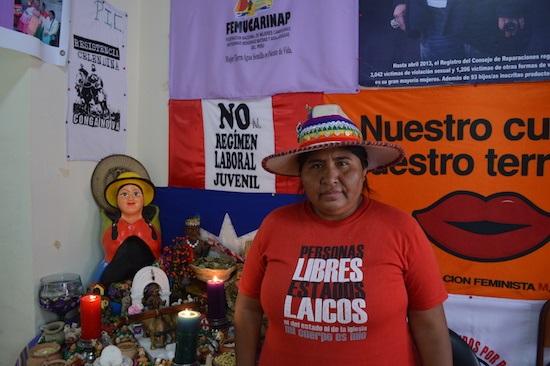Author: Ella MacKinnon
Co-Authors: Kelsey Newhook, Eileen Molloy, Alina Schroeder, Justin Anderson
Peru’s Connection to Its Past From A Health Perspective
Peru has an interesting past and current relationship with public health. Infectious diseases were the main cause of the decline of the Incan Empire, the original inhabitants of Peru. Native people had no immunity to any of the diseases the Spanish invaders brought with them, and as a result were killed off in dramatic numbers. Today, the risk for infectious disease is very high in Peru, with ailments ranging from hepatitis A to malaria, Zika virus, and dengue fever (The World Factbook). The WHO reports that the average life expectancy is 74 for men and 77 for women, which is higher than the global averages. However, the country spends a mere 5.5% of its GDP on healthcare related expenses.

Traditional Peruvian Shamans
Peru’s Healthcare System Today
Since the collapse of the Peruvian healthcare sector in the 1980s and ‘90s, the country has been able to increase health services and clinics available (especially in rural areas) and decrease infant mortality and malnutrition. However, significant issues are still at hand. There are vast disparities between the level of health care available for the lower- and upper-middle classes in Peru. Lower income citizens generally are less educated and are subjected to unsafe environmental conditions, which coupled with decreased access to health services, leads to circumstances such as the surprisingly high infant mortality rate considering the country’s GDP (WHO). In one rural community in the Peruvian Amazon called Flor de Primavera, a nurse technician named Senaida Marinas has been working with the community for the past 4 years in an effort to bring healthcare to the roughly 1,100 people living there. She has been assisted by USAID‘s Quality Healthcare Program (Chemonics). This provides a possible solution to address the lack of access many remote and lower-class communities have to healthcare.
In 2015, over 20,000 public health care workers went on strike to put pressure on the government to implement important changes that had been agreed upon the previous year. These changes included making temporary positions into permanent ones, increasing the number of health care workers employed by the government, and raising salaries (Mora 2015). Another factor to consider when looking at Peru’s overall public health situation is that 45% of the population is indigenous, and many indigenous Peruvians either utilize a combination of government and shamanic health care, or rely solely on shamans for their medical needs.

Peruvian Public Health Care Workers on Strike (Mora 2015).
Feminism and Public Health in Peru
During the regime of Alberto Fujimori, many Peruvians experienced a dark and unpromising time that has since come to be called fujimorismo. This part of Peru’s history was characterized by an authoritarian regime and reactionary policies, and it was also the time in which Peru’s government pushed forced sterilization on to many Peruvian women (Ygarza). In 2006, a group was created called the National Federation of Female Peasants, Artisans, Indigenous, Native and Salaried Workers of Peru, or FENMUCARINAP. This organization was founded with the intent of defending women’s rights in Peru, including control of the female body and empowering women politically, economically, and socially. It now is made up of roughly 126,000 members located in 19 different regions of Peru. FENMUCARINAP also continues to seek justice for the more than 300,000 women who were forcibly sterilized under Fujimori’s rule.

Lourdes Huanca Atencio, president of FENMUCARINAP (Ygarza).
Summary Factoids:
- What is an example of an infectious disease that Peruvians are at a high risk for contracting? Dengue fever
- What percentage of its GDP does Peru spend on health expenditures? 5.5%
- What does FENMUCARINAP stand for? the National Federation of Female Peasants, Artisans, Indigenous, Native and Salaried Workers of Peru.
Works Cited
Fafard, Mark and Rob Haley. “Natural Resource Profits and the Implications for Peru’s Public Health System.” International Journal of Sociology & Social Policy, May 2014, pp. 392-400. EBSCOhost, doi:10.1108/IJSSP-07-2013-0069.
Mora, Rael. “Peru: 20,000 Public Health Care Workers Strike.” TeleSur English. N.p., 09 Sept. 2015. Web. 03 Mar. 2017.
“Peru.” World Health Organization. World Health Organization, 2017. Web. 03 Mar. 2017.
“Quality Healthcare Reaches Remote Peru.” Quality Healthcare Reaches Remote Peru | Chemonics. Chemonics International Inc., n.d. Web. 03 Mar. 2017.
“The World Factbook: PERU.” Central Intelligence Agency. Central Intelligence Agency, 12 Jan. 2017. Web. 03 Mar. 2017.
Ygarza, George. “Peru: In Defense of Land, Culture and the Female Body.” Nacla: Reporting on the Americas since 1967 03 June 2016: n. pag. Print.



